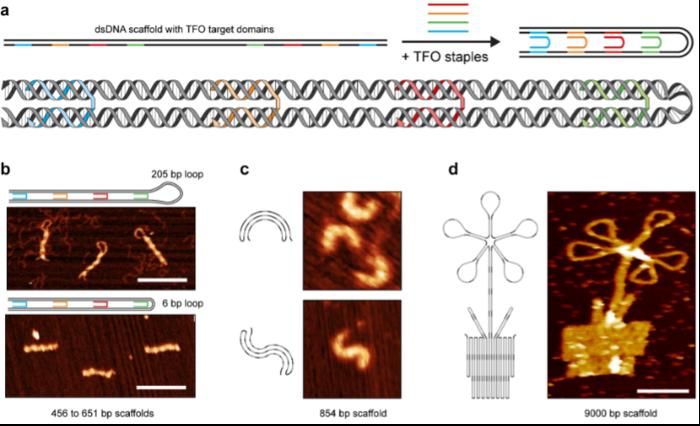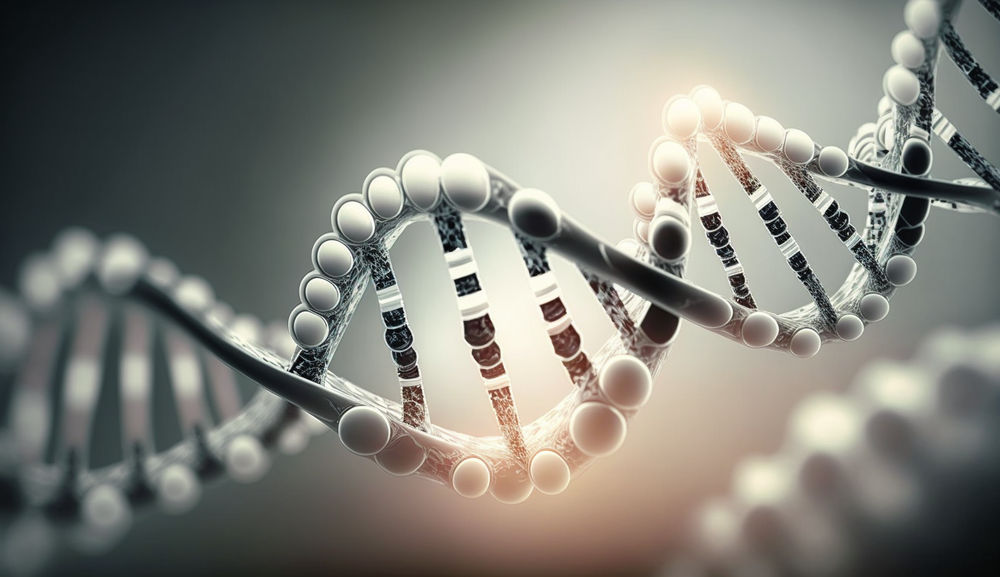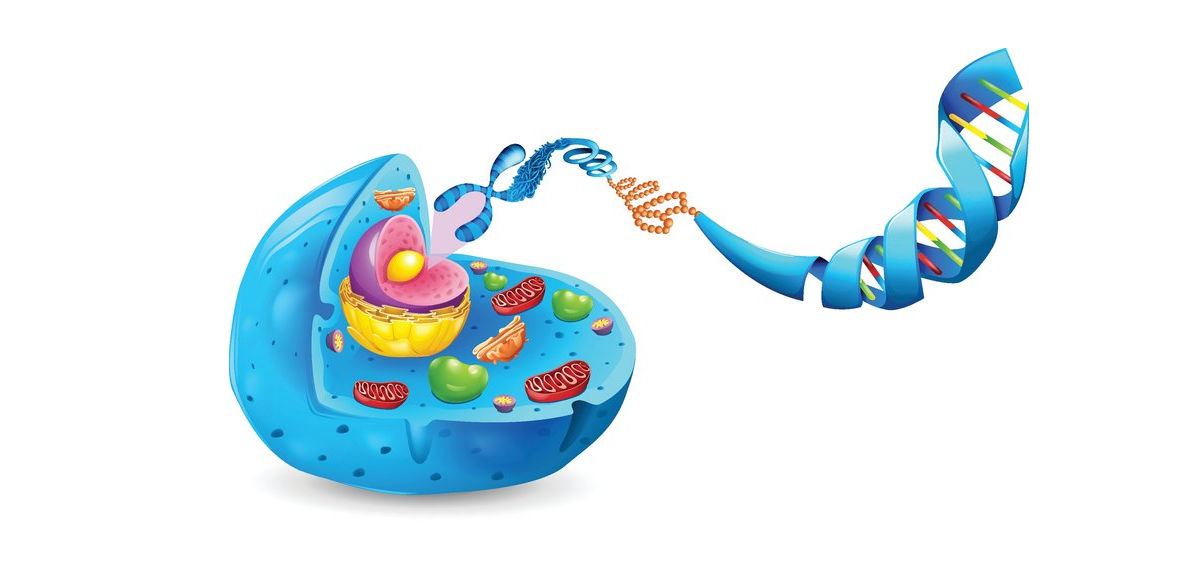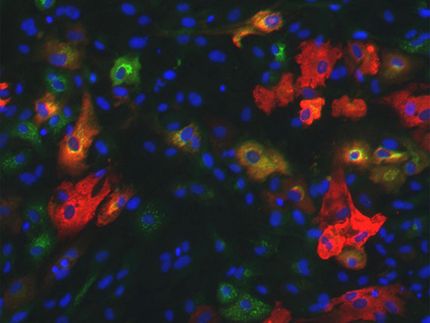Revolutionary new method can manipulate the shape and packing of DNA
The method opening up exciting new avenues for exploration in molecular biology, nanotechnology, and beyond
Advertisement
A human cell harbors roughly 2 meters of DNA, encompassing the essential genetic information of an individual. If one were to unwind and stretch out all the DNA contained within a single person, it would span a staggering distance – enough to reach the sun and back 60 times over. In order to manage such an astounding volume of biological information, the cell compacts its DNA into tightly packed chromosomes.

Triplex-mediated folding of dsDNA, a) A dsDNA sequence containing triplex-forming domains (coloured) is folded by four TFO strands, i.e. single-stranded DNA acting as staples, into a hairpin structure b) Images of two hairpin structures made with atomic force microscopy (AFM). c) S-shaped structure formed from a polypyrin DNA. d) Assembly of a large TFO origami resembling a potted flowerstructure from a 9000 bases long piece of double-stranded DNA. Scale bar = 100 nm
Gothelf Lab, Aarhus University
“Imagine DNA as a piece of paper upon which all our genetic information is written.” Says Minke A.D. Nijenhuis, co-corresponding author. “The paper is folded into a very tight structure in order to fit all of that information into a small cell nucleus. To read the information, however, parts of the paper have to be unfolded and then refolded. This spatial organization of our genetic code is a central mechanism of life. We therefore wanted to create a methodology that allows researchers to engineer and study the compaction of double-stranded DNA.”
Triple helical structure provides protection and compactness
Natural DNA is often double-stranded: one strand to encode the genes and one backup strand, intertwined in a double helix. The double helix is stabilized by Watson-Crick interactions, which allow the two strands to recognize and pair with one another. Yet there exists another, lesser-known class of interactions between DNA. These so-called normal or reverse Hoogsteen interactions allow a third strand to join in, forming a beautiful triple helix.
In a recent paper, published in Advanced Materials, researchers from the Gothelf lab debut a general method to organize double-stranded DNA, based on Hoogsteen interactions. The study unambiguously demonstrates that triplex-forming strands are capable of sharply bending or “folding” double-stranded DNA to create compacted structures. The appearance of these structures range from hollow two-dimensional shapes to dense 3D constructs and everything in-between, including a structure resembling a potted flower. Gothelf and co-workers have named their method triplex origami.
With triplex origami, scientists can achieve a level of artificial control over the shape of double-stranded DNA that was previously unimaginable, thereby opening new avenues of exploration. It has recently been suggested that triplex formation plays a role in the natural compaction of genetic DNA and the current study may offer insight into this fundamental biological process.
Potential in gene therapy and beyond
The work also demonstrates that the Hoogsteen-mediated triplex formation shields the DNA against enzymatic degradation. Hence, the ability to compact and protect DNA with the triplex origami method may have large implications for gene therapy, wherein diseased cells are repaired by encoding a function that they are missing into a deliverable piece of double-stranded DNA.
This biological marvel of DNA sequence and structure has also been applied in nanoscale materials engineering, yielding applications in therapeutics, diagnostics, and many other areas. “For the past four decades, DNA nanotechnology has almost exclusively relied on Watson-Crick base interactions to pair up single DNA strands and organize them into custom nanostructures.” Says Professor Kurt V. Gothelf. “We now know that Hoogsteen interactions have the same potential to organize double-stranded DNA, which presents a significant conceptual expansion for the field.”
Gothelf and co-workers demonstrated that Hoogsteen-mediated folding is compatible with state-of-the-art Watson-Crick-based methods. Due to comparative rigidity of double-stranded DNA, however, triplex origami structures require fewer starting materials. This allows larger structures to be formed at significantly lower cost.
The new method has the limitation that triplex formation typically requires long stretches of purine bases within the double-stranded DNA and the researchers have therefore used artificial DNA sequences, instead of natural genetic DNA. However, in the future they will work towards overcoming this limitation.
Original publication
Other news from the department science
Most read news
More news from our other portals
See the theme worlds for related content
Topic world Gene therapy
Genetic diseases once considered untreatable are now at the center of innovative therapeutic approaches. Research and development of gene therapies in biotech and pharma aim to directly correct or replace defective or missing genes to combat disease at the molecular level. This revolutionary approach promises not only to treat symptoms, but to eliminate the cause of the disease itself.

Topic world Gene therapy
Genetic diseases once considered untreatable are now at the center of innovative therapeutic approaches. Research and development of gene therapies in biotech and pharma aim to directly correct or replace defective or missing genes to combat disease at the molecular level. This revolutionary approach promises not only to treat symptoms, but to eliminate the cause of the disease itself.





























































